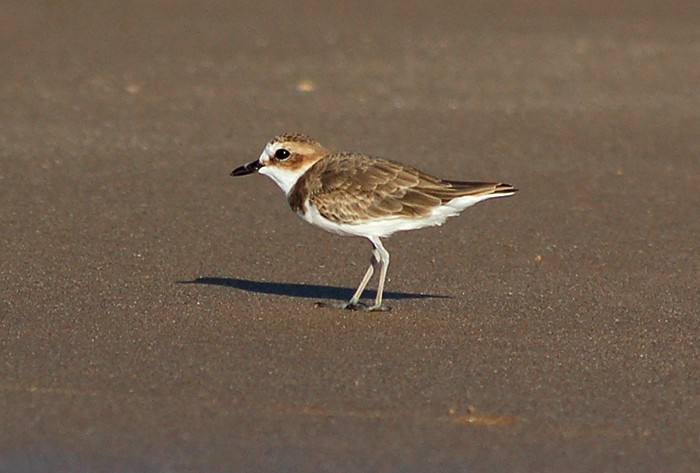Long-billed Plover
A species of Typical plovers Scientific name : Charadrius placidus Genus : Typical plovers
Long-billed Plover, A species of Typical plovers
Botanical name: Charadrius placidus
Genus: Typical plovers
Content
Description General Info
 Photo By 孟宪伟 , used under CC-BY-SA-3.0 /Cropped and compressed from original
Photo By 孟宪伟 , used under CC-BY-SA-3.0 /Cropped and compressed from original Description
The long-billed plover (Charadrius placidus) is a species of wading bird in the family Charadriidae. It can be found in Bangladesh, Bhutan, Brunei, Cambodia, China, Hong Kong, India, Indonesia, Japan, Laos, Malaysia, Mongolia, Myanmar, Nepal, North Korea, Russia, South Korea, Sri Lanka, Taiwan, Thailand, and Vietnam. The long-billed plover is a migratory bird, so it breeds and spends the winter in different parts of its range. This bird can often be spotted along the shores of rivers, streams, in wetlands, and rice fields. It forages on the shoreline primarily for aquatic insects, insect larvae, and other invertebrates. It is difficult to distinguish between male and female individuals because of their similar plumage. The breeding season starts at the end of February or early March and ends in July. A male and a female forms a monogamous pair and maintains their territory throughout the breeding season. A global population survey in 2016 assessed the long-billed plover as a species of least concern on the International Union for Conservation of Nature (IUCN) Red List. 
Size
21 cm
Nest Placement
Ground
Feeding Habits
Long-billed Plover primarily consume aquatic insects and invertebrates, including midges, dragonflies, beetle larvae, flies, and earthworms. They forage along shorelines, quickly capturing prey with their long bill, and may eat crustaceans like mysid shrimps. Long-billed Plover avoid plant material in their diet.
Habitat
Long-billed Plover typically inhabits the gravelly, stony, or shingled areas bordering rivers and lakes for breeding. This bird's preference for a habitat extends to the shingle banks of large rivers and muddy environments, including agricultural fields post-harvest and tidal mudflats, during the non-breeding season. Additionally, long-billed Plover is also known to frequent coastal beaches and artificial environments such as sewage ponds.
Dite type
Insectivorous
General Info
Feeding Habits
Bird food type
Distribution Area
The long-billed plover is widely distributed throughout South and East Asia. It is quite uncommon throughout its range and occurs in small numbers. Breeding ground generally includes western, northern, and central parts of China, Japan, North Korea, and South Korea. Many instances of breeding activity have been reported in the Bureya river and other parts of far east Russia, Honshu island in Japan, southeastern China, and in the western Arunachal Pradesh in India near the Himalayas. This species has also been spotted during its breeding season in Singapore. The long-billed plover travels south of its breeding range to spend the winter. It generally winters throughout eastern Nepal, northeast India to Indochina, southern China, South Korea, Honshu, Shikoku, and Kiyushu islands of Japan, Taiwan, Myanmar, Malaysia, and Thailand. Populations on the three main islands of Japan do not generally migrate south, and are year-round residents. Only the population in Hokkaido travel south to winter in warmer climates. Long-billed plovers prefer to inhabit the shores of rivers, streams, and lakes with small, round pebbles and rocks. They tend to nest on small temporary shingle islands or pebble spits that form between the different branches of meandering mountain rivers. These islands cannot be prone to frequent flooding, and need to be at least 600 square meters in area. The islands also need to have large patches of stones and pebbles that are 30-60 millimeters in size. Their habitats are often surrounded by shrubs, willows, and young forests. Long-billed plovers can also be found in freshwater wetland habitats and rice fields in the winter. These birds tend to avoid sandy beaches, mudflats, and areas with large boulders. 
Species Status
The long-billed plover is listed as a species of least concern on the IUCN Red List because of its wide distribution and large home range. It has a distribution range that exceeds 20,000 square kilometers. The global population seems to be decreasing, but the rate of decline is not drastic enough to make this species vulnerable. Population decline has to be more than 30% over ten years or three generations for a species to be deemed vulnerable. Even though long-billed plovers are not vulnerable or threatened now, their population might decline rapidly in the future due to the loss of suitable breeding grounds. Conservation efforts should include protection and restoration of breeding habitats. Habitat restoration projects can provide new breeding habitats through the artificial construction of gravel banks and pebble islands. 
Scientific Classification
Phylum
Chordates Class
Birds Order
Shorebirds Family
Plovers Genus
Typical plovers Species
Long-billed Plover